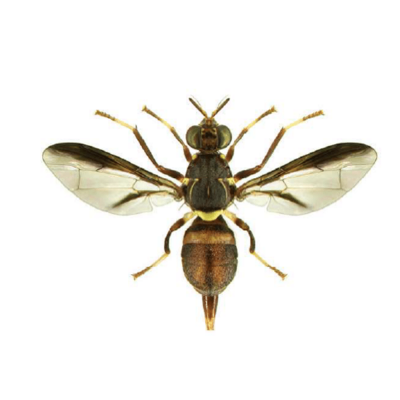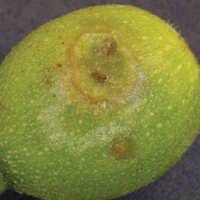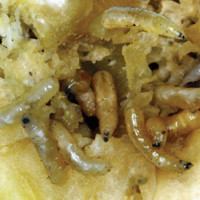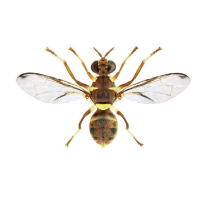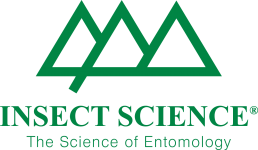Host plants
All five species primarily attack cucurbits, but Dacus bivittatus, Dacus bivittatus and Dacus ciliates also attack tomatoes and Dacus bivittatus also attacks eggplant. Dacus vertebratus is more common on watermelon. Other crops attacked as secondary hosts include green beans, papayas and granadilla.
Damage
Apart from flowers that are sometimes attacked, pumpkin flies have a preference for young, soft fruit, smaller than 100 mm. The sites where eggs are laid are usually referred to as “sting sites”. The areas around these “sting sites” sink in (illustrated) and the fruit discolours around the eggs. The symptoms persist even when eggs fail to hatch. Damage is therefore irreversible and fruit may be deformed without rotting. Feeding by the larvae (illustrated) and secondary infections cause the fruit to turn soft and rot rapidly. Sometimes young fruit are aborted by the plant and some fruit will fail to ripen, while others continue to grow, but will be severely deformed. Sometimes excess fluid produced by the fruit oozes from affected areas and excreta of maggots may also be present. Puncture sites are vulnerable to secondary infestations by pathogens and other insects, i.e. other non-related fly larvae.
Pumpkin flies are significant pests of cucurbits and sometimes cause serious yield loss. They are especially troublesome late in the season when most of the young fruits are attacked. Their status as pests of cucurbits varies from year to year.
Life history
After mating, females lay their eggs under the skin of fruit, in groups of fewer than 10. The eggs take approximately two days to hatch and the larvae live for approximately seven days inside the fruit where they remain until they are ready to pupate in the soil. Fully-grown larvae leave the fruit after approximately a week of feeding and move to the ground. Here they bury themselves shallowly in loose soil, usually under or close to the fruit. When the soil is too hard or compact, the larvae characteristically propel themselves to a more suitable location, by folding the body in two, and releasing their grip at the right moment, thrusting themselves forward for distances up to 160 mm. This is a dramatic but quick and effective way to escape unfavourable conditions and to dislodge predators like ants.
Adult pumpkin flies emerge after approximately two weeks and following another two weeks they are sexually mature. These flies can live up to six months under favourable, cool conditions. Adult flies are often associated with plants other than their host plant, using nearby plants as hiding, resting or overwintering sites, and are also frequently seen consuming honeydew produced by hemipteran insects. Plants with extra-floral nectaries also attract adults. The adults are the overwintering phase. They sometimes congregate in numbers in protected areas during the colder winter months when host plants are not available. However, in modern climates, when host plants are available, they continue to develop throughout the winter month (e.g. in greenhouses and tunnels).
Natural enemies
At least one parasitic wasp, the braconid Fopius bevisi (Brues), is known to attack the larvae of Dacus ciliatus in South Africa. This natural enemy is, however, ineffective in keeping pumpkin fly numbers below threshold.
Management
Pumpkin fly numbers take a long time to build up to economic levels (their life cycles usually last about two months). Plantings between December and February suffer more severe losses than those planted earlier. To lessen the build-up of fly populations within gardens, it is crucial that all infested fruit be removed and destroyed. Deep burial is sometimes the only way to prevent larvae from maturing in discarded produce. In areas with prevailing high ambient temperatures and low humidity, infestations are usually less severe.
Several insecticides are available for control of pumpkin flies, of which baits are the most effective as they target the adult flies before they can attack fruit. Flies can only lay eggs after maturing for a period of 1-3 weeks, during which they feed extensively on sweet liquids and are then more likely to be attracted to poisoned sweet baits. These baits can also be applied to other plants or surfaces and are effective when sprayed in areas where overwintering populations occur. Preventative control is possible and it is advisable to be on the lookout for adults even before a cucurbit crop is planted. Apart from preventative spraying before cucurbits are planted, the first in-field sprays should be timed to coincide with the appearance of flowers. Whatever control measure is used, it is critical that young, small fruit be protected as pumpkin flies cannot puncture old fruit, and fruit larger than 100 mm is usually less attractive. Larger fruit with visible lesions is common, but this is a result of an earlier infestation when fruit was much smaller and younger.

